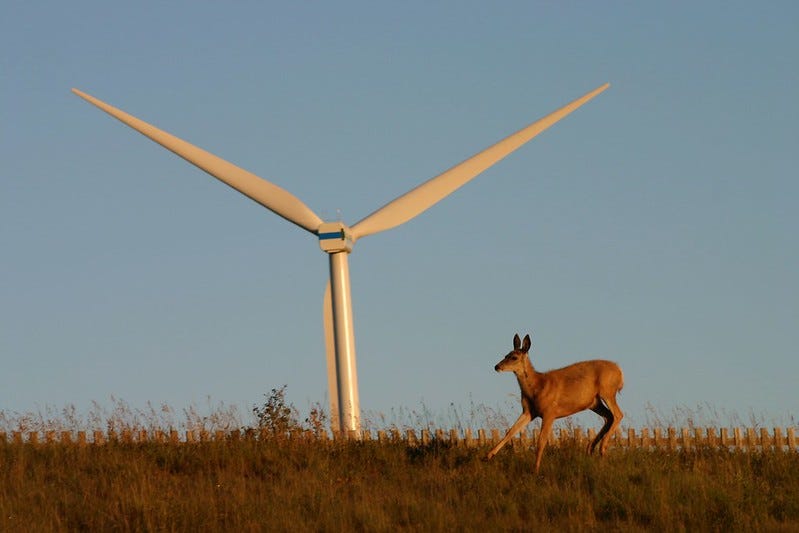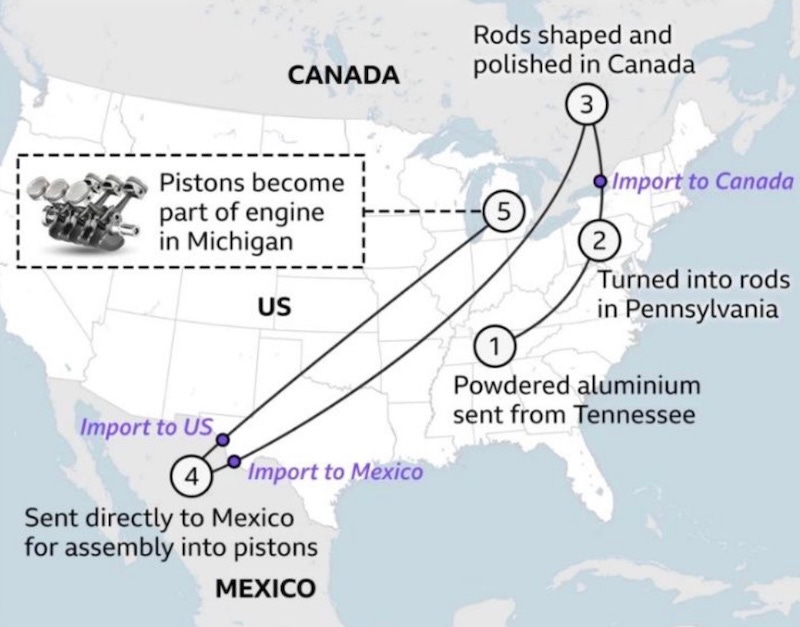Quicker, Smaller, Better: A Fork in the Road That Delivers a Clean Energy Future
This post includes a link to sign the Pledge for Canada and stand up for the sovereign country we want, with the clean, decarbonized energy system we need. You know what to do.

As Donald Trump’s malicious tariff disruptions begin to bite, and Canadians unite around the diversified economy that will assure our national sovereignty, there’s a narrow window of opportunity to translate some standard fossil industry rhetoric into an energy future for the rest of us.
For so long, many of the industries most responsible for the climate emergency and other environmental and social harms have cajoling and arm-twisting governments to boost efficiencies by speeding up project approvals and cutting red tape. That’s usually code for gutting regulations that were put in place for good reasons—protecting us from climate pollution, health and safety hazards, waste disposal nightmares, or economic and social harms caused by unethical operators run amok.
Elon Musk and his co-president are about to give us a master class in why those regulations matter, with the United States as their increasingly toxic playground.
But what if there were a way to get the faster approvals the private sector is asking for by pouring financial and policy support into the projects and technologies we want? The ones that are vastly less hazardous to start with, create good, local jobs, build community strength and resilience, and gradually replace the industries that brought climate change to our doorstep and Donald Trump to our border?
Think of it as Canada’s fork in the road. Just not the way Musk meant it when he used that term to hound and harass tens of thousands of U.S. public servants out of their jobs.
The Projects We Want to Speed Up
We’ve known for decades, not years, that there’s a smart, systematic way to run an energy transition. The fine details have shifted over time, but the basic prescription has not.
Start by drastically increasing the energy efficiency of everything.
Electrify key end uses like cars and other vehicles, home heating and cooling, and many industrial processes, now with the added reliability of affordable energy storage, while decarbonizing the electricity system.
Make it an absolute, top priority to phase out emissions of methane—the main component of natural gas, a climate-busting super-pollutant with 84 times the impact of carbon dioxide over a 20-year span, and our single best chance to achieve major climate gains by 2030.
Pay careful attention to the relatively few, more complicated energy uses—like air travel and some heavy industries—that aren’t so simply decarbonized.
And, crucially, cut with both arms of the scissors by pairing the rise of renewables and energy efficiency with a managed phaseout of the oil, gas, and coal industries whose products are frying the planet when used as directed, while devastating local ecosystems and communities along the way.
With rapid emission cuts and deeper climate resilience as our top-line goals, the energy transition also delivers on the quicker business opportunities that industry has been demanding—even if those aren’t the opportunities the fossil lobby had in mind when it was doing the demanding.
Even at relatively large scale, solar and wind farms are faster to approve and build than fossil fuel plants, pipelines, or nuclear reactors, largely because they have a far smaller physical and environmental footprint. They generally come in on time and on budget because, unlike the most mega of megaprojects, they aren’t too big to succeed.
Go behind the meter, to the realm of deep energy retrofits, home heat pumps, rooftop solar panels, solar+storage, and community microgrids, and you can afford to speed up the process even more, as long as developers know how to open real conversations with local communities and earn their support.
“The modular nature of solar and wind construction allows for faster development and more predictable construction timelines and costs at different scales,” Eyab Al-Aini, senior research associate, clean growth at the Canadian Climate Institute, said in an email this week. “Unlike gas turbines or nuclear generation, where pressure on a few suppliers can limit choice and stretch timelines, the distributed nature of solar equipment manufacturing lowers overall project execution risks.”
Al-Aini added that smaller projects can face lighter permitting requirements because they often “bypass the transmission planning process, can leverage existing onsite assets (roofs, permits),” while benefitting from fewer technical reviews and bypassing long waits to connect to the grid. And behind-the-meter solar and wind, “especially when combined with storage, can both reduce overall site energy use from the grid and also be a source of power during peak demand.”
Note that every megawatt of peak power demand a community can save through energy efficiency or generate behind the meter is a megawatt that needn’t be supplied by methane-intensive gas plants that provincial premiers like Doug Ford are so intent on building in places like Ontario.
The Road Not Taken
Smaller-scale energy isn’t quite as simple as I’m making it sound, and decades ago, a decision on which kind of complexity to embrace was instrumental in bringing us the oil sands industry as we know it today.
When I worked at the late, lamented Canadian Renewable Energy News, like any other early 1980s news outlet in a world before PDFs, we received our share of news leaks in hard copy, delivered in (literal or metaphorical) plain brown envelopes. One draft memo, printed on the recycled map paper that signposted its origins in the then Department of Energy, Mines and Resources, compared the costs and benefits of subsidizing a heavy oil upgrader in Alberta against an equivalent investment in a national home insulation program.
Its conclusions were stunning: The insulation plan would save more energy than the upgrader would produce, creating more jobs that were more evenly distributed across the country. But federal bureaucrats were said to be petrified at the thought of staking the success of their decision on millions of individual, local choices, rather than a single, high-stakes negotiation among first ministers.
You know where that story ended: The upgrader went ahead, and to this day, Canada and especially Alberta are overly dependent on the boom-and-bust industry that received that initial infusion of government largesse, and has been steadily polluting the countryside and our national politics ever since.
New Pipelines Would Need Massive Subsidies
But now, with Canada’s very existence at stake, that history points to another advantage in accelerating the kind of energy projects we need and want. The ones that increase community control rather than obliterating it and reduce greenhouse gas emissions rather than driving them through the roof.
From the moment the current occupant of the White House began trumping up his baseless case for tariffs and economic annexation, his allies and paymasters in the oil and gas industry knew what to do. The largely American-owned companies in the Alberta oilpatch, many of which no doubt to contributed to the industry’s lavish and “breathtakingly corrupt” investment in bringing Trump back to power, immediately dusted off every pipeline megaproject they’d failed to push through over the last decade. Suddenly, industry lobbyists and elected officials (led by the former lobbyist who’s now an elected official) were touting carbon bombs like the Energy East and Northern Gateway pipelines as the path to our economic salvation, even the key to our national identity.
“Being so dependent on the United States for the export of oil is a vulnerability,” Natural Resources and Energy Minister Jonathan Wilkinson said late last month, calling for a national conversation about whether the country should reconsider building a new east-west oil pipeline.
A scant two weeks later, Wilkinson had largely changed his tune, or at least added a badly-needed harmony line. “Everybody’s sort of running around saying, ‘Oh my God, we need a new pipeline, we need a new pipeline,’” he told the Globe and Mail. “The question is, ‘Well, why do we need a new pipeline?’ And I think it’s important to have the conversation, but let’s start with facts.”
Beginning, presumably, with whether anyone would actually want the job of constructing it. “If there's an economic case, you would assume there's a proponent, and the proponent will build it,” Wilkinson said, in an interview with CBC. With the companies that originally pitched Energy East and Northern Gateway no longer in the oil pipeline business, and no avid advocate on the horizon, “people are jumping to a solution before they've actually talked through the challenges,” he added. “One is, is there an economic case for such a pipeline? And the second is, is there a national security rationale?”
Globe and Mail columnist Adam Radwanski has a good idea of how those questions would be answered. The very obvious absence of any private investors tripping over each other to build new pipelines:
…suggests enormous subsidies would be required to attract the capital, if not outright government ownership. The rationale would have to be that given the security dangers posed by Mr. Trump, Canada can no longer rely on oil from the U.S., or flowing through the U.S., to supply eastern provinces.
But as Mr. Wilkinson noted, there is no way a pipeline would be completed in less than five years. That wouldn’t make it much help with the threat posed this decade by Mr. Trump. And by then, the shift toward electric vehicles—which Mr. Trump may slow, but won’t stop outright as those vehicles get cheaper—could mean less oil is needed.
Even if subsequent events have blunted the International Energy Agency’s projection that oil demand will peak this decade, Radwanski adds, “placing a huge bet against it happening next decade isn’t wildly appealing.”
The Canadian Energy We Want
Trump’s threats, combined with a cascading climate emergency and the unparalleled opportunities in the energy transition, have opened up a path to the energy system we need and want.
As Prime Minister Justin Trudeau said so eloquently last week, there are no winners in a trade war, and none of us wanted one. But we know the assignment. Canadians are seeking out and finding homegrown alternatives to U.S.-made products, cancelling trips across the border, cheering as provinces pull American brands off liquor store shelves (while mocking a Trump executive order signing along the way), and appropriating a classic by iconic American singer Gloria Gaynor to assert that *We* Will Survive:

(American friends and allies: Hang in for the line about welcoming you back with open arms, “once you see your foolish trade war would have done too much harm.”)
At this writing, nearly 75,000 have signed the Pledge for Canada, which calls for solidarity among Canadians and across political and regional lines to:
• “Assert and protect the sovereign right of Canadians to shape their own political, economic, social, and cultural destiny”;
• Protect our democracy from disinformation and foreign interference;
• Increase Canadian resilience by reducing our dependence on the U.S.;
• Seek and build alliances with like-minded countries;
• Give priority to “protecting nature, to preserving control over our lands and water systems, and to resolute action on the climate crisis.”
Living up to those fundamental Canadian values will mean picking the legitimately clean, green energy projects that support the nation we want to build. And recognizing that making good decisions goes beyond just choosing the end use energy we want.
It All Comes Back to Community
Even or especially as we face down an existential external threat, we have to be honest about a legacy of resource extraction projects—from fossil fuels and pipelines to mining and forestry—that have too often left communities behind and their land base indelibly altered. Changing the channel on that history begins with not repeating the same old, bad old practices of bulldozing projects through local objections, or accelerating approvals and permitting so fast that communities can barely catch their breath, much less assess the impacts and have their say.
If we’re joining together to protect Canada as a nation that is different and distinct, that cannot and must not mean deregulating ourselves out of the values—social and spiritual, economic and physical—that we’ve set out to protect.
We’re in a moment when politicians across the spectrum are tapping into a powerful vein of community pride and purpose. It’s playing out at the national level in response to an international threat. But it traces back to the people, places, and things we know and love—and so much of what we’re all scrambling to defend is local.
That means we don’t want an ExxonMobil subsidiary polluting Indigenous lands and withholding the information from communities for months, or an Australian coal magnate planning a widely-hated megaproject in the Rocky Mountain foothills, any more than we support Elon Musk’s U.S. gigafactory dumping waste in the Nevada desert and harassing whistleblowers who try to tell the story.
It means holding clean energy projects to those same standards, even knowing that they start out delivering more benefits and fewer impacts than the fossil fuel developments they replace. And setting the expectation that renewable energy developers will consult pro-actively, listen attentively, and look at community input as an opportunity to maximize benefits, minimize impacts, and dodge major flaws in a project design before it’s too late—not just an exercise in box-checking.
We didn’t need Donald Trump to remind us that the energy transition is meant to be about building something better, not just replacing one set of crappy, corrupt industrial practices with another one. Now we get to prove it, in a moment and on a scale where failure is not an option.
Mitchell Beer traces his background in renewable energy and energy efficiency back to 1977, in climate change to 1997. Now he and the rest of the Energy Mix team scan 1,200 news headlines a week to pull together The Energy Mix, The Energy Mix Weekender, and our weekly feature digests, Cities & Communities and Heat & Power.
Chart of the Week

What Climate Change Means for Bird Flu—And the Soaring Price of Eggs
77% of Albertans Oppose Coal Mining as Province Lifts Moratorium
Marine Heatwaves Drove Mass Fish Deaths, Deadly Storms, Billions in Damage
Canadian Mining Giants Face Criticism Over Rights Violations, Environmental Harm
‘Farming Sunshine’ Brings Food, Power Producers Together for Local Baaa-nefit
New NB-NS Transmission Line Would ‘Take Care of Home’ Through Trump’s Trade War
Brookfield Spends $1.74B on Renewable Assets as Analysts Trace Fossil Fuel Holdings
Medicine Hat Weighs Options for Solar Park Amid Alberta’s Pricey Renewables Rules
CDPQ Gains 3.7-GW Innergex Portfolio in $10B Deal
Restricting power across U.S.-Canada border risks grid stability, NERC warns (Financial Times)
Trump’s Executive Order on Forests ‘A Devastating Blow,’ Activists Say (Inside Climate News)
ExxonMobil Stock Hits New 52-Week Low (Benzinga)
How Utility Customers Wind Up Paying to Serve Data Centers (Heatmap)
Families to lobby for end of oil and gas extraction in UK (The Independent)
MLAs call on NWT to declare state of emergency in Norman Wells (Canadian Broadcasting Corporation)
Putin ally pushes deal to restart Nord Stream 2 pipeline with U.S. backing (Financial Times)
Europe’s Largest Battery Goes Live in Blackhillock, Scotland (Zenobē)
Uttarakhand avalanche triggered by 600% surge in precipitation (The Times of India)
Melting Ice Could Slow Vital Antarctic Ocean Current (Barron’s)
Rising Temperatures Are Scrambling the Base of the Ocean Food Web (New York Times)
World's largest iceberg runs aground off remote island (British Broadcasting Corporation)
Rising temperatures drove 41% surge in peak power demand in India in 2023 (The Times of India)





Thanks, all. David and Bob, there's indeed a lot of work being done on aviation fuels, but I haven't heard that there's anything easy about it, or anything that is anywhere near ready for prime time. Links and references always welcome if there's any new research we should be looking into!
It is, or should be, easy to decarbonize air travel. It is not only possible, but has been done, to take carbon dioxide out of the air and convert it to a fuel such as gasoline or kerosene which can then be used in airplanes. David Keith set up his company, Carbon Engineering, in Squamish BC, to do just that. I gather he is setting up a larger company in the USA to do it. It may cost a little more than fuels from the oil companies, but so what? This will be much cheaper than paying for damage from hurricanes, floods and droughts. I would like to know why not?